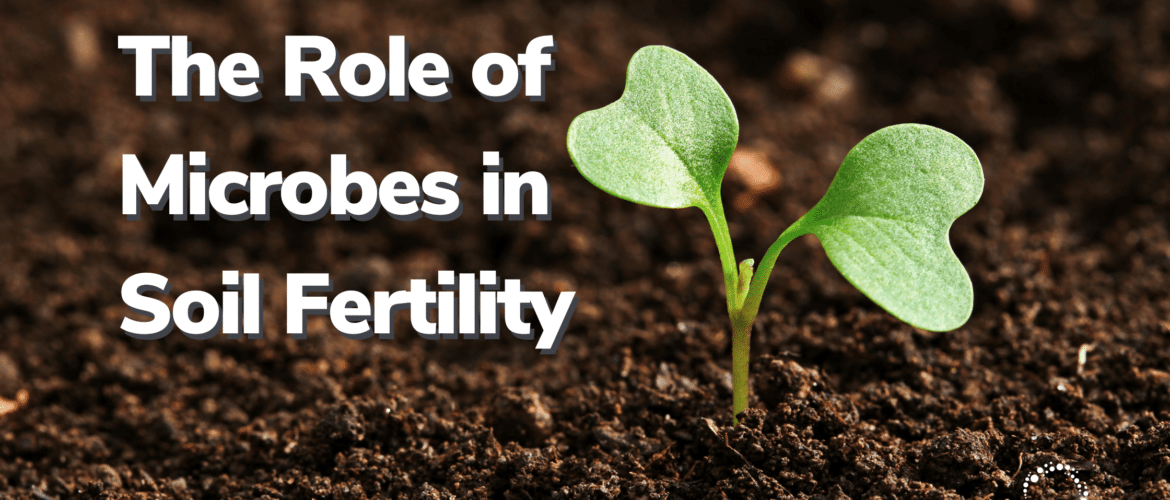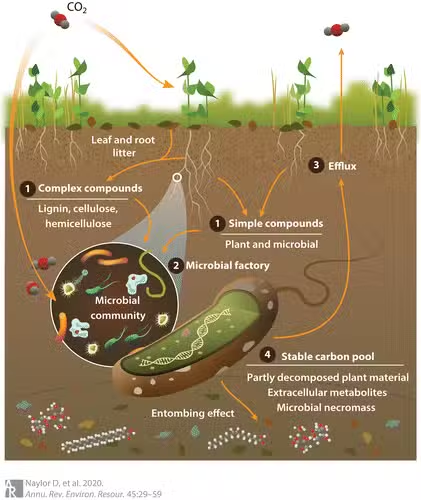
The Role of Microbes in Soil Fertility
Did you know that plants spend a good portion of their energy ‘feeding’ beneficial soil microbes? In turn, these microbes in the soil play an important role in plant performance by improving mineral nutrition and disease resistance. Read on to learn more about the role of microbes in soil fertility.
In this blog:
- Soil microbes definition
- The importance of soil microbes
- What is the rhizosphere?
- The beneficial impact of soil microbes in the rhizosphere
- Why do plants need the microbial bridge?
- How do you build the microbial bridge?
- Enhancing microbial diversity
- Growing mixed plant species
- Start taking care of your soil biology
- How are soil microbes affected by commercial cropping and fertilisation?
- Is fertiliser a friend or foe?
- How to improve the number of microbes in agricultural soil
- Our experience with soil microbes and fertiliser
- RegenZ supports healthy soils and tailored fertilisation
Soil microbes definition
What are soil microbes? Soil microbes consist of:
- Bacteria
- Fungi
- Actinomycetes
- Algae
- Protozoa
- Nematodes
All these microbes are beneficial for building soil health, structure, and fertility. Soil microbes occur in enormous biodiversity in the soil and are responsible for the majority of soil enzymatic processes in soil. They also store energy and nutrients in their biomass.
DID YOU KNOW? There are more microbes in a teaspoon of soil than there are people on the earth.
The importance of soil microbes
The soil is more than simply a source of nutrients to plants; it is a complex ecosystem of soil-dwelling organisms. Plants exhibit a diverse array of interactions with these microbes and other living organisms. Thus, they improve plant nutrition and health and improve the quality of the soil. This important activity takes place in the rhizosphere.
What is the rhizosphere?
The rhizosphere is an intense hub of activity in the soil. In this root zone around plants, plant roots feed nearby soil microbes in exchange for plant nutrients. In this way, the rhizosphere is the “bridge” where unavailable minerals are turned into plant nutrients.
Here’s how it works:
- Roots put sugars down into the soil through photosynthesis
- This creates an area of crowded, busy bacterial feeding in the rhizosphere
- Roots exchange that microbial food for nutrients the plant needs
DID YOU KNOW? Only 55-75% of plant sugars support plant growth, reproduction and defence from pests. The rest go into the soil through the roots to feed the soil biology.
The above is a simplified version of events. The truth is that we know that there are intimate, symbiotic associations between mycorrhizal and rhizobial bacteria and plants—but we have only scratched the surface of how the signalling between them works. What we do know is that by secreting and detecting diversified signalling agents, plants and microbiomes in the rhizosphere have a strong mutual influence.
The beneficial impact of soil microbes in the rhizosphere
 Plant sugars from the roots feed the soil microbes; the bacteria and other organisms living in the rhizosphere make nutrients available to the plants AND provide a protective layer against pests and diseases.
Plant sugars from the roots feed the soil microbes; the bacteria and other organisms living in the rhizosphere make nutrients available to the plants AND provide a protective layer against pests and diseases.
Why do plants need the microbial bridge?
Plants need the minerals found in the soil to grow, photosynthesise, flower, pollinate and produce fruit or seeds. Although soils are composed of around 45% minerals, most of those minerals are not in a form the plant can use.
Soil microbes are the bridge between the soil minerals and the plant roots:
- Nitrogen – Although plants are surrounded by nitrogen in its gaseous form in the atmosphere, only microbes are able to turn it into a usable form. Microbes also transform soil organic nitrogen into mineral nitrogen (ammonium and nitrate) that plants can take up.
- Sulphur – It takes soil microbes to change organic sulphur in the soil into plant-available sulphate.
- Phosphorus – Organic phosphorus is mineralised to plant-available forms only through microbial activity.
- Many other micronutrients also benefit from the microbial bridge to make them plant-available.
With nutrient movement and nutrient-holding capacity, microbes can: change the form of a nutrient to make it plant-available ; change a mineral’s acidity or alkalinity ; hold nutrients in a way that makes it easier for a plant to take them up when needed.
How do you build the microbial bridge?
Enhancing the strength of the microbe bridge comes down to a number of different practices that involve feeding an abundance of soil biology year-round:
Enhancing microbial diversity
Crop diversity leads to abundant biology, which is key to building a strong microbe bridge. Having different kinds of plants means a more diverse array of soil life, since plants are specific to their microbes.
Growing mixed plant species
By growing mixed plant species, you are able to populate a more heterogeneous group of microbes in the soil. This means that no one population can become dominant, building a stronger microbial bridge that provides a variety of minerals essential for plant health.
Start taking care of your soil biology
Switching your focus from chemical inputs to taking care of soil biology allows for a stronger and more effective microbial bridge. Rather than relying on soluble fertilisers for plants, the microbes are able to effectively deliver the correct nutrients to plants in the right forms and quantities.
Depending on manual inputs is expensive and unsustainable; by focusing on soil health and biology, building a strong microbial bridge will put you on the road to successful farming in the future.
How are soil microbes affected by commercial cropping and fertilisation?
We generally associate agricultural fertiliser applications with improved plant growth. However, it’s important to remember that fertiliser nutrients are not only exposed and available to the plant, but also to all the organisms and soil microbes within the soil system. As we’ve discussed, soil microbes play an important part in getting nutrients into plants and improving soil fertility, which are crucial factors in overall plant health. That’s why we need to consider the impact of intensive fertilisation on the numbers and activities of native microbes in the soil.
The most commonly held perspective is that fertiliser applications have a negative effect on soil microbes. Fertilisers, especially inorganic fertilisers, are often associated with upsetting the microbial balance and therefore the health of the soil. While this may be the case in some instances (particularly with regard to the excessive applications of products such as potassium chloride and nitrates), fertilisers are still an essential component of viable cropping, including those microbes that play an important role in facilitating the uptake of most nutrients required by plants.
Recent advances in technology have allowed researchers to better measure the total microbial biomass and identify the specific microbial families in the soil in order to assess the impact of fertilisation on the soil microbes.
The observations are complex, for example:
- The application of nitrogen may decrease the number of nitrogen-fixing bacteria in a sample. However, the same application could increase the total amount of microbes involved in degrading crop residues.
- Fertiliser applications increase enzyme activities related to nutrient cycling.
- Some findings show that fertilisers promote microbial growth and activity, which goes against commonly-held beliefs.
Is fertiliser a friend or foe?
There’s no ‘one-size-fits-all’ approach as there are so many variables involved. All soils, microbes and fertilisers are unique, and different environments have varying interactions between these elements. Some of the factors influencing the relationship include:
- Soil type
- Native microbe populations
- Fertiliser amounts, placement and formulations
Interactions among soils, microbes, fertilisers and plant roots occur in various combinations. So, what works for one environment doesn’t necessarily work for the next! In particular, the microbial population in the soil, especially in the root hair soil interface (rhizosphere), is extremely complex.
Photosynthesis is the critical process that determines plant quality and yield. If the delicate rhizosphere balance is not optimal, photosynthesis will be compromised. The first signs of compromised photosynthesis are disease and insect pressure.
As the single most important natural process on Earth, photosynthesis is dependent on naturally-available elements – carbon dioxide, water and sun (all free!) – for 95% of its function. The balance (5%) comprises nutrients taken up by the plant. In nature, these nutrients are also free; in commercial agriculture, they are added in the form of organic and inorganic nutrients.
Thus, there is a role for fertilisers to play in commercial farming practices. However, the application of fertiliser requires a tailored approach of what should be applied, and when it should be applied – all dependent on the condition and nature of the soil. Applying the correct fertilisation is not just a matter of inputting a fertiliser that worked for a fellow farmer and waiting for an amazing yield.
How to improve the number of microbes in agricultural soil
A healthy soil requires much more than the handful of nutrients that usually make up inorganic fertilisers. The diversity of the soil microbe can be improved by:
- Cover crops
- Green manures
- Biochar
- Compost
- Products derived from organic raw material, such as fish hydrolysate (natural amino acids), Amino K (fermented molasses) and kelp (plant hormones).
These organic products are efficiently taken up directly by plants as foliar applications, but are most beneficial as microbe food sources in the soil. The rich concentrations of amino acids, fermentation metabolites, plant hormones, soluble carbon (as opposed to humus), to name a few, act as immediately-available microbial food sources. This stimulation of the soil microbial population triggers and magnifies the uptake of more traditional nutrients (macro, micro and trace elements), and thus results in a better yield.
Our experience with soil microbes and fertiliser
Biological fertilisers can have a positive effect on the health, number and diversity of soil microbes. We’ve found that it’s best to apply small amounts of organic additives at regular intervals to avoid spikes in microbial activity. These products can be incorporated as part of a regenerative farming approach.
RegenZ supports healthy soils and tailored fertilisation
RegenZ offers two sustainable-use products that promote beneficial microbes in the soil:
- Tiny Team: a concentrated probiotic soil inoculant.
- Nutri-Life Platform®: adds Arbuscular Mycorrhizal Fungi (AMF) to the soil
We know that every situation is unique, which is why we offer our products on a consultative basis and include sustainable solutions that promote soil health. Get in touch with the RegenZ team to find out more.

About the Author: Justin Platt
Justin is the Founder & CEO of Zylem and RegenZ. Justin has a BSc in Plant Pathology and Botany from UKZN. He has been involved in the agricultural services industry since graduating in 1979. Justin has a passion for regenerative agriculture.